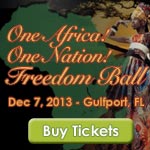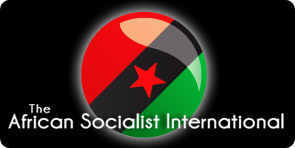Political Report to the Fifth Congress of the African People’s Socialist Party
Join the online studies / discussions: May 2 | May 9 | May 16
Table of Contents
- Imperialists cannot stem tide of national liberation
- The Party is the anti-colonial force in this time
- African People’s Socialist Party is heir to Marcus Garvey
- Pan-Africanism was the petty bourgeoisie; Garvey led the African working class
- African Internationalism advances Garvey Movement, defines imperialism in crisis
- African Internationalism shows the way forward
- African Internationalism led on the issue of reparations
- African workers must lead the struggle against parasitic capitalism
- ASI is the basis for a genuine Communist International
- White nation-state built on pedestal of slavery, colonialism
- White communists must be committed to overthrowing white power
- The African Socialist International is growing in Africa
- ASI resolution adopted at Party’s First Congress
- InPDUM leads mass resistance
- Revolutionary National Democratic Program: the political basis for black power
- Black is Back Coalition helps to advance RNDP
- African People’s Solidarity Committee another vehicle against U.S. imperialism
- White people must side with African workers not parasitic capitalism
- AAPDEP a tool against parasitic capitalist development
- AISO wins students to African Revolution
- African Redemption Church: the Party’s response to religious idealism
- Influencing and organizing African labor
- Party must address issue of African mass incarceration
- Formalizing the leadership of African women
- Solve the problem of recruitment
- Accountability and democratic centralism
- Party’s Department of Agit Prop has made great leaps
- Cadre development and leadership is key
- Office of Economic Development builds culture of self-reliance
Pan-Africanism was the petty bourgeoisie; Garvey led the African working class
There were other African movements during this period of the rise of Marcus Garvey, and nearly all of them fought Garvey tooth and nail. Although many of these other groups claimed progressive motivation (for example, some called themselves socialists and communists), they all saw themselves struggling for a bourgeois emancipation of African people within imperialist-created borders and definitions.
This was true of the African Assimilationists and other accommodationists who simply capitulated to imperialism under the existing capitalist system, as well as of the Pan-Africanists who organized themselves into a political movement in opposition to the Garvey Movement, sometimes with practical unity and assistance from the imperialists.
The Pan-Africanist movement was created by a sector of the African petty bourgeois Assimilationist movement in the U.S. that was aligned with liberal white imperialist capitalism. It was willing to recognize a relationship between Africans worldwide, but was incapable of recognizing Africans as part of the same dispersed nation that had to be physically liberated and united.
It refused to recognize the need to struggle against white imperialist power for the achievement of a single nation-state, a requirement for harnessing and developing the productive forces necessary for African progress. In later years some progressive Africans such as Kwame Nkrumah ascribed to what they called Pan-Africanism, but it was clearly a different Pan-Africanism than that of W.E.B. DuBois, the National Association for the Advancement of Colored People (NAACP) and those associated with him during the formative, anti-Garvey stage of the Pan-Africanist movement.
Nkrumah, Patrice Lumumba, Walter Rodney and Mangaliso Sobukwe were anomalies within what was referred to as the Pan-Africanist movement because their politics put them squarely in the camp of African Internationalism. Even so the influence of Pan-Africanism caused Nkrumah, Lumumba and Sobukwe to meet with political disaster and even death. Without the strength of the armed revolutionary party of the African working class, Nkrumah was overthrown in a U.S.-backed coup in Ghana, Lumumba was assassinated by imperialist forces in Congo, and Sobukwe was imprisoned in Occupied Azania.
This makes another, essential point about the inadequacies of Pan-Africanism: it permits everyone who is called a Pan-Africanist to be characterized as such, whether reactionary or revolutionary.
The UNIA under the leadership of Marcus Garvey was also notable for its inclusion of the laboring masses of the African world as leaders and members. This was a huge departure from the tradition of the Assimilationists and others who created the Pan-Africanist movement. The Pan-Africanists were essentially intellectuals without a mass base until after they, along with a host of Garvey opponents in tactical alliance with the U.S. government, succeeded in effectively destroying the Garvey Movement thereby setting up their own movement as Garvey’s apparent heir.
The Garvey Movement developed and thrived during an era of imperialist instability when the entire world was engaged in the debate about identity brought about by intra-imperialist struggles for advantage over their adversaries in acquiring slave labor, markets and raw materials.
Garvey brought the Africans into this debate with a bold move for liberation and acquisition of an all-African nation-state. His movement demanded that Africans worldwide recognize that Africa is our national homeland, requiring our collective, organized action for its liberation and unification and the consolidation of the African nation-state.
Many so-called progressives have been ambivalent about the significance of the Garvey Movement, and some prefer to remember him as a deranged bourgeois nationalist. This is a measure of their fidelity to imperialism.
The validity of the Garvey Movement can be measured both by the fact that it was part of the worldwide movement for national liberation against colonial domination raging during that period, and that Garvey’s organization and newspaper influenced many of these struggles around the world.
Notable leaders of the period included Ho Chi Minh of Viet Nam, Sun-Yat Sen of China, Emiliano Zapata and Pancho Villa of Mexico, Faribundo Marti of El Salvador and Augusto Sandino of Nicaragua, to name only a few of the heads of national liberation movements to wrest control of their countries and peoples from the avaricious grasp of imperialism. None of these leaders and movements was more significant than Marcus Garvey and the UNIA that he created and led.














